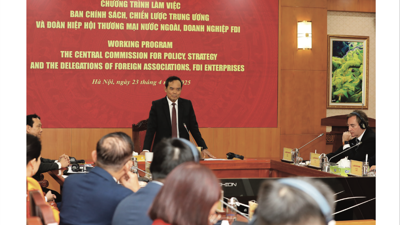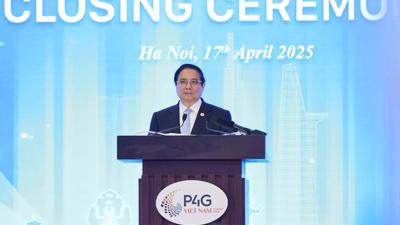Partners for the planet
On the occasion of the 78th Republic Day of Italy on June 2, H.E. Marco della Seta, Ambassador of Italy to Vietnam, spoke with VET about enhancing the bilateral relationship between the two countries.

What are your thoughts on the current status of economic relations between Vietnam and Italy, especially in terms of trade and investment?
Italy and Vietnam have developed strong economic ties, characterized by significant growth in trade and investment. Bilateral trade has seen a steady increase, with Italy being one of Vietnam’s top 3 trading partners within the EU. Vietnam, meanwhile, is Italy’s leading economic partner in the ASEAN region. Bilateral trade in 2023 reached $6.1 billion.
A crucial factor has been the entry into force of the EU-Vietnam Free Trade Agreement (EUVFTA), in 2020, which boosted bilateral trade. Despite the pandemic, bilateral trade between Italy and Vietnam increased by over 14 per cent between 2019, before the EUVFTA came into effect, and 2023.
Key sectors include machinery, pharmaceuticals, chemicals, steel, textiles, leather and footwear materials, coffee, mobile phones, and other electronic devices.
Despite the advancements made by both countries, what sectors remain underexplored for collaboration? What strategies would further enhance bilateral ties?
Vietnam has set ambitious goals for development and ecological transition in the coming decades. The country is determined to shift its industrial and service sectors towards higher-value segments in value chains. Today, Vietnam is no longer solely a destination for investment in low value-added manufacturing.
For these reasons, I believe there are many opportunities in sectors where Italy already excels in Vietnam, such as machinery and the pharmaceutical industry. Because of Vietnam’s economic and social development, these sectors offer significant potential for growth. Undoubtedly, there are also considerable opportunities in renewable energies and smart agriculture; fields where Italy has expertise, companies, and experience. The full entry into force of the EU-Vietnam Investment Protection Agreement (EUVIPA) will certainly help in this regard.
Lastly, the two governments should facilitate business-to-business contacts. A good example of such support is the three technological centers financed by the Italian Trade Agency: one in southern Binh Duong province for leather and footwear, another in Ho Chi Minh City for the textile industry, and a third for the stone sector, established in the summer of 2022 in northern Yen Bai province. These technological centers are the result of cooperation between national business associations on both sides.
In what ways could enhanced collaboration between the two countries bolster collective efforts to address and resolve global challenges, including but not limited to climate change, food security, and water security?
Our two countries already cooperate in addressing climate change, especially in water management-related issues. Among many, I would like to mention a project aimed at developing a platform for the management of the Red River basin and a remote sensing technology project for establishing and implementing geographical information on vulnerability to climate change, risk assessments, and environmental monitoring systems for Vietnam.
Italy’s expertise in sustainable agriculture, water management, and climate-resilient technologies can complement Vietnam’s efforts to enhance food security and water security. By sharing knowledge, technology, and best practices, the two countries can improve agricultural productivity, promote sustainable farming practices, and mitigate the impact of climate change on food production and water resources. Collaborative projects in renewable energy deployment, energy efficiency, and climate-resilient infrastructure can accelerate the transition to a low-carbon economy and reduce greenhouse gas emissions, thus contributing to global efforts to combat climate change.
How would you evaluate investments undertaken by Italian enterprises in Vietnam, and Vietnam’s investment climate for Italian businesses? What sectors are prioritized by Italian enterprises for investment in Vietnam, and how can Vietnam facilitate the expansion of Italian investment?
Italian enterprises have been actively investing in Vietnam for almost three decades, with a focus on manufacturing and consumer goods. Vietnam’s investment climate has proven, over the years, to be attractive due to its stable social and political system, economic growth, young workforce, and favorable investment policies.
Over 150 Italian enterprises currently operate in Vietnam through production plants, commercial branches, exclusive distribution agreements, and agency deals. Italian investments in Vietnam are noteworthy, particularly in manufacturing, with a presence in the infrastructure, pharmaceutical, mechanical, digital, and insurance sectors. Italy’s investment in Vietnam exceeds €1 billion ($1.08 billion), and some Italian enterprises have chosen Vietnam to host their Asian headquarters or to establish research and development (R&D) centers.
Of many, I would mention Ariston Thermo, one of the first Italian investors in Vietnam, 35 years ago, and currently operating in northern Bac Ninh province; Piaggio, with its largest Asian production plant, in northern Vinh Phuc province; and Fincantieri, with its Vard shipyard in southern Ba Ria-Vung Tau province. There are other outstanding and globally-renowned Italian companies producing in Vietnam, such as Bonfiglioli, Dainese, Mapei, Datalogic, Hung Yen KD (the Carvico Group), Madex, and many more.
There is still room for further expansion, however, especially in high-tech industries, renewable energies, and services.
To further facilitate Italian investment, Vietnam could enhance its investment environment by streamlining regulatory procedures, reducing bureaucratic redundancies, improving and ensuring a reliable and stable supply of clean energy, and strengthening intellectual property protections.
Could you elaborate on the collaborative efforts between Vietnam and Italy in fostering green and sustainable development initiatives? How do the complementary strengths of the two economies contribute to advancing sustainability cooperation?
When it comes to green and sustainable development, there are several complementarities between the contributions that Italy can provide and the ambitious goals set by Vietnam for the next few decades. Italy’s expertise in renewable energy and environmental technologies complements Vietnam’s efforts in transitioning to a greener economy. Specifically, there are opportunities in wind power, waste management, the circular economy, and sustainable agriculture.
Italy is already particularly active in the field of sustainable agriculture. This was a central topic of discussion during the visit by Italian Minister of Agriculture, Francesco Lollobrigida, in March, where he met with high-level Vietnamese authorities. At the Embassy of Italy in Hanoi, we presented a study conducted in collaboration with the Vietnamese Institute of Agricultural Engineering and Post-Harvest Technology (VIAEP) last January, and we are currently working on several initiatives to contribute to the modernization, productivity, and sustainability of Vietnamese agriculture. Italy’s robust expertise in renewable energy technologies positions it as a valuable partner of Vietnam, which is actively seeking to increase its renewable energy capacity as part of its commitment to reducing greenhouse gas emissions. Italian companies can contribute in an array of ways, including solar, wind, and hydropower. Italy’s expertise in small-scale hydropower management could be highly relevant given Vietnam’s extensive hydropower plant systems.
Another promising area of cooperation is developing facilities that convert waste into energy, where renewable energies intersect with waste management. These facilities not only reduce landfill use but also generate renewable energy, contributing to both waste management and energy goals. Italy has great experience in waste-to-energy projects and can partner with Vietnam in implementing technologies and processes that efficiently convert municipal and industrial waste into energy.
Italy has affirmed its commitment to allocate €250 million ($271 million) to Vietnam from the Green Climate Fund under the Just Energy Transition Partnership (JETP) framework to combat climate change. Can you elaborate on Italy’s role in facilitating Vietnam’s transition towards environmental sustainability through the JETP initiative?
Italy and Vietnam are both vulnerable to the adverse effects of climate change, and face challenges such as rising sea levels, extreme weather events, and shifts in agricultural productivity. Recognizing the urgency of addressing these issues, Italy has pledged to mobilize €500 million ($542 million) to support Vietnam’s path to net-zero under the G7-led JETP.
Of the total pledge, €250 million will come from Italy’s Climate Fund and can be deployed through sovereign and non-sovereign loans, guarantees to financial institutions, indirect equity, and grants dedicated to technical assistance. The remaining €250 million will be offered by the Italian Development Finance Institution - Cassa Depositi e Prestiti, in parallel with financing provided through the Climate Fund for bankable projects.
Italy has longstanding expertise in several areas complementary to the scope of the JETP, such as energy efficiency, the circular economy, and sustainable agriculture. Through the JETP mechanism, Italy aims to support comprehensive initiatives that not only reduce greenhouse gas emissions but also enhance the overall resilience of Vietnam’s infrastructure and communities. Italy’s expertise in renewable energy technologies, smart grid systems, and energy efficiency can be instrumental in helping Vietnam develop cutting-edge solutions tailored to its specific needs.
However, the JETP is only a first step, aimed at showing the way for much bigger private investments that are large enough to meet the scale of the challenges in energy transition.
Finally, given the celebrations last year of the 50th anniversary of diplomatic relations between the two countries, what long-term prospects do you foresee?
2023 was a special year for the relationship between Italy and Vietnam. We jointly celebrated not only the 50th anniversary of the establishment of diplomatic relations but also the 10th anniversary of the signing of the Declaration for the Establishment of a Strategic Partnership. Exchanges of political visits have been happening regularly on both sides. Among many, I would like to name the visit to Italy by Mr. To Lam in July 2023, who was then Minister of Public Security, and is now the State President, and the State Visit by former State President Vo Van Thuong.
The 50th anniversary of diplomatic relations marks a significant milestone in our partnership, paving the way for future cooperation. However, I see the 10th anniversary of our Strategic Partnership as even more significant. The Strategic Partnership has elevated our bilateral engagement to a more advanced level. We are both committed for the long run to enhancing political collaboration bilaterally and in all international forums; further strengthening economic ties by fostering growth in trade and investment; and increasing cultural and people-to-people exchanges to reinforce mutual knowledge and understanding.







